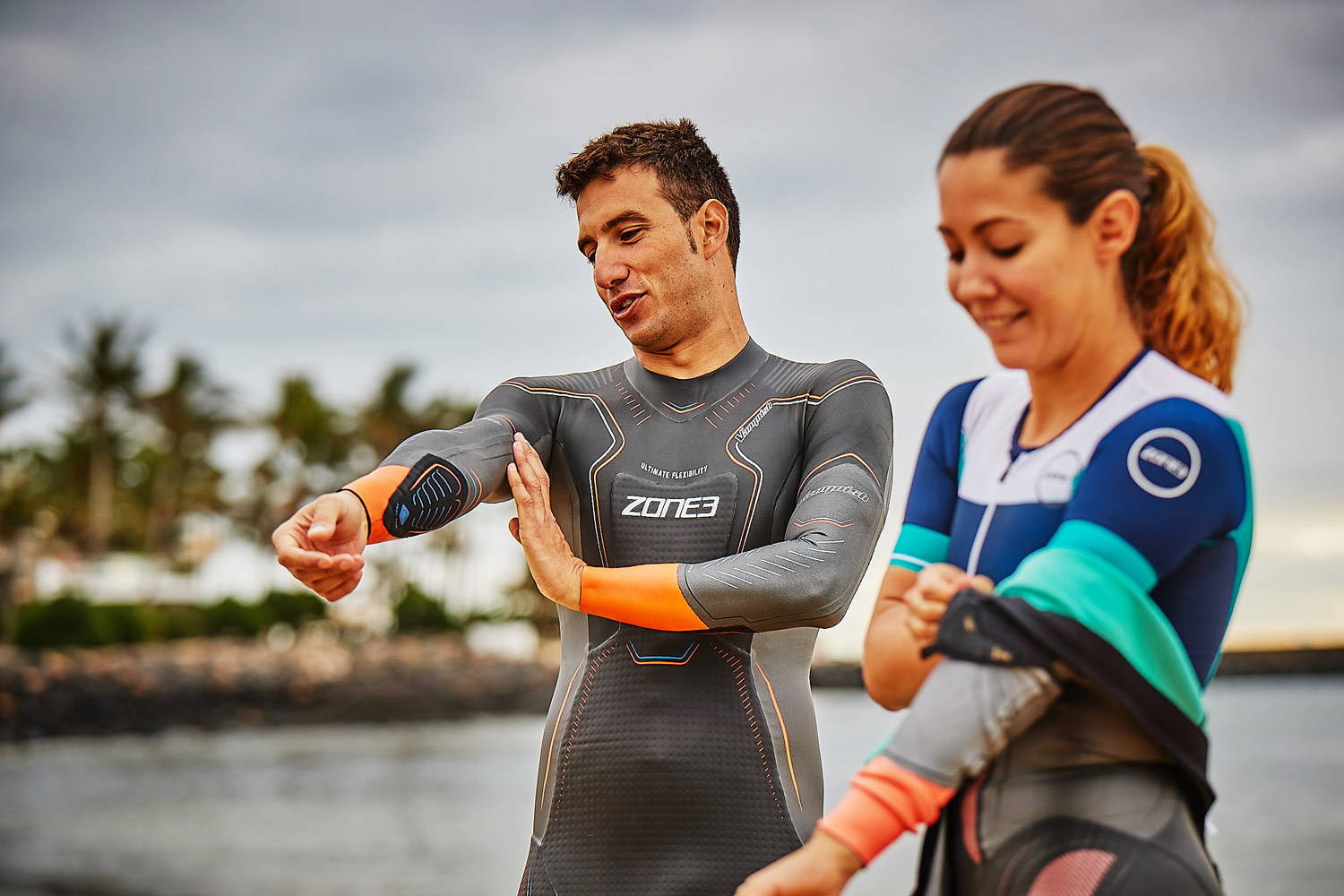Der Neo gehört - neben dem Fahrrad - zu den langfristigen und kostenintensiveren Anschaffungen bei Triathleten. Daher soll er natürlich möglichst lange halten. Damit eure zweite Haut möglichst lange in perfektem Zustand bleibt, haben wir einige Tipps für euch zusammengestellt. Denn euer Wetsuit will gut gepflegt werden!
1) Kein Stress beim Anziehen
Gerade für Einsteiger ist das erste Anziehen ungewohnt, denn die Passform eines Neos ist bewußt eng anliegend und leicht kompressiv angelegt. Das bedeutet, dass der Anzug mit viel Gefühl an alle Körperstellen gezogen werden muss. Das richtige Anziehen dauert halt ein paar Minuten - das Ausziehen hingegen nur ein paar Sekunden. Lasst euch deshalb Zeit beim Anziehen und reißt nicht mit Gewalt am Material. Hektik ist ein schlechter Begleiter, lasst euch bei Bedarf einfach helfen. Doch keine Sorge: mit ein bisschen Übung hat man die Handgriffe ganz schnell verinnerlicht.
2) Trockener Anzug auf trockene Haut
Bevor ihr den Neopren anzieht, solltet ihr euch komplett abtrocknen. Neopren gleitet viel besser auf trockener als auf nasser Haut. Ebenso sollte das Innenfutter des Neoprens trocken sein. Wenn eure Füße zusätzlich noch in Socken stecken oder mit einer kleinen Plastiktüte bedeckt sind, rutscht der Neo besser darüber.
3) Neopren auf links gedreht anziehen
Um die empfindliche Außenhaut beim Anziehen zu schützen, dreht den Neo zum Anziehen auf "links" und rollt ihn am Körper nach oben auf. Wichtig ist es hier, sorgfältig von unten nach oben zu arbeiten. Hier findet ihr unsere Anleitung: NEOPRENANZUG RICHTIG ANZIEHEN.
4) Vorsicht vor Fingernägeln
Fingernägel sind beim Anziehen der größte Feind des Neos. Einen guten Schutz vor Schäden durch Fingernägel bieten auch hier Plastiktüten oder weiche, dünne Handschuhe.
5) Schäden am Anzug möglichst schnell kleben
Sollte Euer Anzug doch einmal beschädigt sein, dann könnt ihr kleine Cuts schnell und unkompliziert auch selbst reparieren. Zumeist handelt es sich um kleine Einrisse der oberflächlichen Neoprenschicht (oftmals durch Fingernägel oder spitze Gegenstände). Diese lassen sich aber mit speziellem NEOPRENKLEBER zuverlässig versiegeln. Kleinere Cuts sind nicht schlimm und stellen keine Beeinträchtigung der Funktionalität des Anzugs dar. Jedoch solltet ihr mit der Reparatur nicht zu lange warten, denn wenn das Material beim Tragen des Neos gedehnt wird, wächst der Riss um ein paar Millimeter weiter. Größere Beschädigungen überlasst ihr besser den Profis beim Händler eures Vertrauens.
6) Keine ölhaltigen Substanzen verwenden
Öl ist ein Lösungsmittel. Daher solltet ihr zum Schutz vor Scheuerstellen ausschließlich Produkte ohne ölhaltige Substanzen verwenden. Ein spezielles Produkt gegen Scheuerstellen ist zum Beispiel BODYGLIDE
7) Nach dem Schwimmen Neopren auswaschen
Nach dem Kontakt mit Chlorwasser sollte der Neoprenanzug auf jeden Fall gründlich mit klarem Wasser ausgewaschen werden. Ein spezielles Neoprereinigungs-/Pflegemittel hilft dabei zusätzlich, organische Reststoffe, Schmutz und Gerüche zu entfernen. Zum Trocknen solltet ihr den Anzug dann auf links gedreht aufhängen. Ist der Wetsuit trocken, wird er zum Aufbewahren wieder auf rechts gewendet. Wie ihr den Neo nach dem Schwimmen am besten behandelt und am besten lagert, lest ihr > hier
8) Kein UV-Licht
Gummi wird bei dauerhafter Bestrahlung mit UV-Licht spröde. Das sieht man zum Beispiel an Fahrradreifen, die immer im Licht stehen. Daher sollte der Neoprenanzug möglichst wenig der Sonne und Lichteinstrahlung ausgesetzt werden. Überwintern lässt sich der Anzug am besten an einem dunklen und trockenen Ort im Liegen. Spezielle Neopren-Kleiderbügel mit breiter Auflagefläche verhindern ein Ausbeulen des flexiblen Stoffes. So kann Euer Anzug auch einmal länger unbeschädigt abhängen.
9) Nur zum Schwimmen einsetzen
Neoprenanzüge im Triathlon sind aufgrund ihrer Materialbeschaffenheit nicht geeignet zum Surfen, Kiten oder Tauchen.
DIE GROSSE NEOPRENTESTTOUR 2025
+++ Finde den richtigen Neo +++
Welcher Neoprenanzug ist am besten für mich geeignet? Bei unseren Neotest-Events findest Du es heraus. Hier bieten wir Dir eine riesige Modellauswahl und professionelle Beratung. Hier sind die Neotests in Deiner Nähe:




















